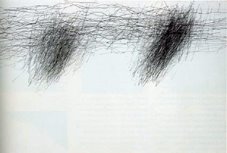
I've been making myself read for at least half an hour a day over the last week and have started with 'Drawing is another kind of language, Recent American Drawings from a New York Private Collection' ed. P.Lee....(ISBN 0-916724-96-4). It's a catalogue I had on my wish list for a long while until recently tracking a copy down. Looking through it, I came across a subway drawing by William Anastasi (above) - a series I had heard about but hadn't seen an example of before. Marks would be dictated by the rhythms of the subway train he was riding on - often on the way to visit John Cage. By coincidence my holiday reading arrived today - 'Silence: Lectures and Writings' by John Cage (ISBN 0-8195-6028-6).
Sound is something I have been thinking about lately in relation to my own work - or maybe rhythm - or time - or movement - or the relationship between all four, not really sure how it all fits together yet as I'm still contemplating possibilities and potential dead-ends. It started a couple of years ago whilst at Tate Modern; looking at Bill Viola's Five Angels from the Millenium I became aware that it was the sound accompanying the images which made the viewer turn towards each projection. I had also been thinking about the visual rhythm' of a video of the gesture of drawing I had made (no soundtrack) and how a pencil mark could whisper or shout (at it's simplest: a 9H will whisper - a 9B shout?). A few of the questions this has led to are: can a visual mark equate to a sound? do rhythmic marks give a sense of sound? how do sound, movement, mark and rhythm work together? when drawing from sound how does the delay between hearing and mark making fit and how can a sound and mark which relate be executed simultaneously? Absolutely no idea what the answers are.....

No comments:
Post a Comment